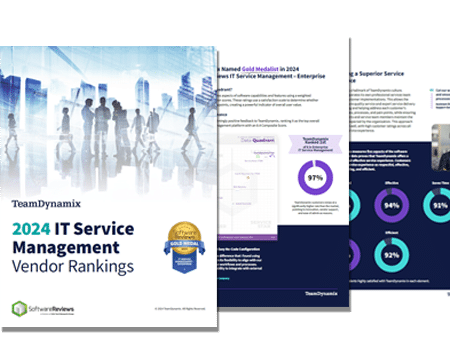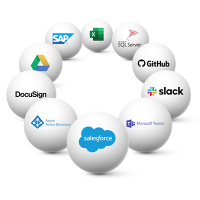
IT Service Management (ITSM): Self-Service Adoption
IT Service Management (ITSM) is evolving and with it, many IT leaders are seeking ways to improve service delivery. In a recent market study, 78%

The Info-Tech ranking report offers a unique view of the market based entirely on in-depth customer interviews. Download the Info-Tech ITSM Quadrant and Customer Viewpoint report today.

We’ll show you some of our best situations and show you exactly how to execute them to get immediate results. The best part is, iPaaS tools often feature easy-to-use click and drag functionality, meaning you don’t need a dedicated employee building integrations and workflows.

System Integrators, Value Added Resellers, Technology Providers, and Buying Consortiums can benefit from a partnership with TeamDynamix.

The Info-Tech ranking report offers a unique view of the market based entirely on in-depth customer interviews. Download the Info-Tech ITSM Quadrant and Customer Viewpoint report to gain a better understanding of key vendor strengths and emerging market requirements.
The IT service desk plays a critical role in any organization, serving as the primary point of contact between customers/end users and the IT support team.
However, service desk operations can often be a challenge, especially when there is an overwhelming volume of requests and tickets to deal with. But with the right tools, processes and strategies, IT teams can overcome these challenges and offer more effective support to their customers and other end users.
In this post, we’ll look at some of the challenges facing IT service desks and how no-code ITSM tools, integration and automation capabilities, a focus on self-service and the use of conversational AI can help resolve them.
There are a number of challenges facing IT service desks – from a dramatic increase in ticket volume to battling budget and resource constraints while still providing great customer experiences despite the growing workloads. Here are the top 3 IT service desk challenges:
Despite these challenges, there are ways to improve your IT service desk and overall IT Service Management. These improvements can help organizations struggling with resource constraints and help to free up IT service desk employees to work on higher-priority projects. Here are three places to start:
With a no-code IT Service Management (ITSM) tool, IT teams can automate many of the processes associated with ticket handling, such as routing, escalation and resolution. These no-code ITSM tools do not require the intervention of highly technical personnel to set up – meaning almost anyone in your organization can contribute meaningfully to setting up proper ITSM processes. No-code ITSM tools can help organizations tackle IT service delivery more efficiently, offering faster resolution time, improved service quality and greater satisfaction levels.
The benefits are amplified when you use an ITSM tool, like TeamDynamix, that offers no-code integration and automation capabilities using iPaaS with your ITSM tool. Integration platforms as a Service (iPaaS) can help connect different IT tools and more (like Active Directory, Workday, Salesforce, etc.), including monitoring tools, ticketing systems and collaboration tools. Furthermore, automation tools can automate many of the manual processes associated with ticket handling, such as ticket routing, SLA management and notification, freeing up IT teams to focus on complex issues that require their unique technical skills.
Casino Arizona and Talking Stick Resorts have set up workflows within TeamDynamix that automatically request a manager’s approval when needed. For example, if someone needs temporary access to a physical location or a software application they wouldn’t normally have access to, they can request this access through the service portal, and it triggers the appropriate approvals.
With the casino’s legacy ESM platform, requests for approvals would sometimes sit in managers’ email inboxes for days. But with TeamDynamix, users can easily track the status of requests from the convenience of their phone and resend a request as needed. The system also can be configured to resend a request automatically after a certain amount of time has passed without a response.
“Being able to see requests in real-time and resend notifications as needed has been a huge asset to our department,” IT Support Manager Jonathan Vorndran said. “It helps move the approval process along faster.”
“I would say we averaged four or five days to obtain proper approvals with our previous system,” Program Manager Adam Dunn adds. “Now, we’re looking at one or two days. We’re talking about a 70-percent decrease. If you need access to an application, waiting four days for all the approvals to take place and get you into the system keeps you from being able to do your job. Getting that down to just a day or two has been critical for us.”
Regardless of the ITSM tool you have in place, one of the first things any organization can do to help lessen the strain on its IT service desk is to implement a self-service strategy as part of its service management and delivery. Service desk teams can encourage self-service through the provision of relevant knowledge and resources via a self-service portal. The portal should be easy to navigate, with frequently asked questions, step-by-step guides and helpful tips. The portal should also have a search function to allow users to find quick solutions to their issues. You also want your portal to have an easy-to-find form that can be filled out if they still need assistance, when that form is submitted it should be set up to automatically route to the right person for resolution.
Having a customizable and easy-to-use service portal has been a game changer for Ellsworth Adhesives, a global corporation that supplies a wide range of adhesives, sealants, lubricants, coatings, encapsulants, tapes, soldering products, surface preparations, specialty chemicals and dispensing equipment.
Within the IT department, the help desk used to receive about 80 percent of service requests through email, 15 percent through phone calls and walkups and only 5 percent through the service portal. Now, 95 percent of requests come through the portal, 5 percent come through walkups, and the help desk team no longer accepts email requests.
To make it as easy as possible for people to use the service portal, the IT department created an app that opens the portal automatically on employees’ desktops.
“We were getting 80 to 90 service requests per day, and the help desk team couldn’t filter and rout them all quickly enough,” IT Service Desk Manager Adam Crichlow said. With the portal, however, this all happens automatically. This shift alone has cut the time it takes from creating to resolving a service ticket nearly in half.
Using TeamDynamix “has freed up staff time right away,” Crichlow said—a benefit the company realized “almost on day one” of using the system.
As other departments have seen the efficiencies that TeamDynamix has created, they’ve also adopted the ESM system. The latest department to create its own service portal using the platform is the Environmental Health and Safety team, which never used the old ticketing system for service management before.
One of the most promising trends in IT service desk operations is the use of conversational AI to enhance the self-service portal experience. With conversational AI, users can ask questions and get instant responses. Conversational AI can help users resolve simple issues quickly, without having to contact the IT team. Furthermore, AI can learn from previous interactions and adapt to users’ preferences, making it easier to provide personalized service.
IT service desk operations can come with significant challenges for IT teams to resolve, but with the right tools, processes and strategies, these can be overcome. No-code ITSM tools, integration and automation, self-service and conversational AI can all help businesses and organizations tackle IT service desk struggles more efficiently, offering faster resolution time, improved service quality and greater satisfaction levels to both the IT team and the users.
By implementing the aforementioned solutions, IT teams can improve their service quality while increasing productivity and efficiency, ultimately leading to a more productive organization.

IT Service Management (ITSM) is evolving and with it, many IT leaders are seeking ways to improve service delivery. In a recent market study, 78%

For nearly all organizations, IT Service Management (ITSM) stands as the backbone of operational efficiency, ensuring that IT services align not just with the needs

Did you know that a significant number of IT incidents occur when someone makes a change to one system that then affects other systems in
TeamDynamix’s award-winning SaaS cloud solution offers IT Service and Project Management together on one platform with enterprise integration and automation.
[email protected]
(877) 752-6196
Contact Us
